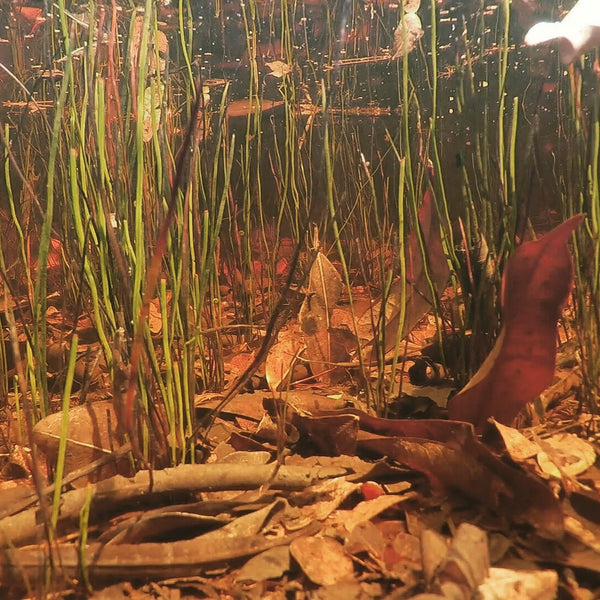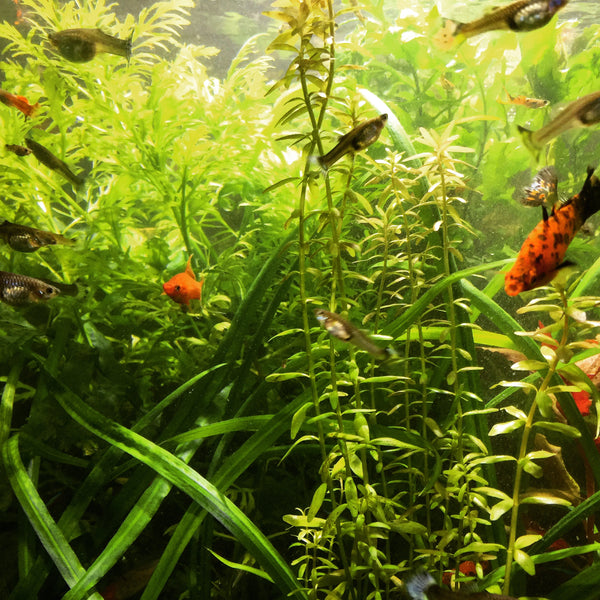- Continue Shopping
- Your Cart is Empty
Faith in Nature- Sustenance from within...
Like many of you, I am absolutely habitual about most things when it comes to my aquariums. I am all about continuous, regular maintenance and dedicated husbandry practices-particularly water exchanges, for which there is simply no substitute for, or no valid reason NOT to execute, IMHO. However, there is one "basic" aspect of aquarium keeping that I have always employed a bit of an "intentional avoidance" of:
Feeding.
"WTF, Fellman. Skip a goddam water change...But feeding? Really?"
Yes. Really.
But before you totally flame me for being hypocritical or lazy, or even guilty of "benign neglect"- hear me out. It's not really about being lazy. It's an intentional thing. I plan for it. In fact, you do too, even though you may not think about it.
Yeah, you do. Stay with me here...

Of all of the things we do in our blackwater/botanical-style aquariums, one of the few "basic practices" that I think we can actually cede some of the work to Nature is to have her provide some sustenance for our fishes.
Think about it: We load up our systems with large quantities of leaves and botanicals, which serve as direct food for some aquatic organisms, such as shrimp and perhaps Barbs and Loaches.
They also serve as a "medium" upon which other food sources accumulate and reproduce.
Most botanicals famously recruit biofilm, algal "patinas", and fungal growths, which we have discussed ad nasueum here over the years. These are nutritious, natural food sources for most fishes and invertebrates. And of course, there are the associated microorganisms which feed on the decomposing botanicals and leaves and their resulting detritus.
All of these are important food sources in Nature, and fulfill a similar role in the aquarium.

Now, we have briefly talked about how decomposing leaf litter supports population of "infusoria"- a collective term used to describe minute aquatic creatures such as ciliates, euglenoids, protozoa, unicellular algae and small invertebrates that exist in freshwater ecosystems.
Yet, there is much to explore on this topic. It's no secret, or surprise- to most aquarists who've played with botanicals, that a tank with a healthy leaf litter component is a pretty good place for the rearing of fry!

It's been observed by many aquarists, particularly those who breed loricariids, that their fry have significantly higher survival rates when reared in systems with leaves present. I'm sure some success of this could be attributed to the population of infusoria, etc. present within the system as the leaves break down. And of course, to the readily available Biofilms, which, as we've discussed many times before, contain a complex mix of sugars, bacteria, and other materials, all of which are highly nutritious for animals which feed on them.

It therefore would make a lot of sense that a "botanical-style" aquarium with a respectable growth of biofilm would be a great place to rear fry! Maybe not the most attractive place, from an aesthetic standpoint- but a system where the little guys are essentially "knee deep" in supplemental natural food at any given time is a beautiful thing to the busy fish breeder, and a welcome sight for fry!

And yeah, my experience indicates it performs a similar role for adults of many species. Even a more aesthetically-focused botanical-style aquarium can perform a "supplemental food generation role" if allowed to do so.
In the wild tropical leaf-litter-fueled ecosystems we love so much, creatures like hydracarines (mites), insects, like chironomids (hello, blood worms!), and copepods, like Daphnia, are the dominant fauna that fishes tend to feed on. Gut content analysis of fishes which inhabit leaf litter habitats reveals a lot of interesting things about what our fishes consume.

For one thing, in addition to the above-referenced organisms, organic detritus and "undefined plant materials" are not uncommon in the diets of all sorts of fishes.This is interesting to contemplate when we consider what to feed our fishes in aquariums, isn't it?

These life forms, both planktonic and insect, tend to feed off of the leaf litter itself, as well as fungi and bacteria present in them as they decompose...Just liek the fishes that are found there. And of course, this "interconnectivity" between various levels of life forms creates the basis for a fascinating and surprisingly productive "food web."
Food webs, defined as "a system of interlocking and interdependent food chains" are fascinating constructs in Nature. The leaf litter bed is a surprisingly dynamic, and one might even say "rich" little benthic biotope, contained within the otherwise "impoverished" blackwaters which surround it.

And, as we've discussed before on these pages, it should come as no surprise that a large and surprisingly diverse assemblage of fishes make their homes within and closely adjacent to, these litter beds. These are little "food oases" in areas otherwise relatively devoid of food.
The fishes are not there just to look at the pretty leaves!
I'll be redundant (again, lol) and assert that it goes without saying that Nature works (if allowed to do so) in a similar manner in the aquarium.
The leaves and botanicals we add to our tanks do what they've done in Nature for eons: They support the basis for a rich and diverse "food web", which enables many of the resident life forms- from bacteria, to insects...right up to our fishes- to derive some, if not all of their sustenance from this milieu.
I'm not an aquatic ecologist or biologist, but based on my years of playing with botanicals in aquariums, I firmly believe that we can at least "construct" or "facilitate" a significant portion of a food web in our aquariums. I've seen my fishes forage among botanicals and decomposing leaves- I've "seeded" leaf litter beds with cultures of microorganisms...Theyre finding food there. And I'm not talking about decomposing TetraMin flakes...

Confession time?
Okay.

I've created botanical tanks for years with part of the intention being to see if I can support the resident fishes with minimal external food inputs. In other words, to not provide supplemental feeding for my fishes other than what they can derive from foraging in the aquarium.
My rationale was that, not only will the leaves and botanicals foster rudimentary "food webs" similar to what they do in Nature, but that the lower amount of external food inputs by the aquarist helps foster a cleaner, biologically "lean" system, which is especially important when one takes into account the large amount of bioload decomposing leaves and botanicals account for in the aquarium in the first place! Like, "enhanced sustainability from minimalism..."
And guess what? It works. Just fine.
Really.
I've done this now 8 times in the past three years, with great results every time-including an uncommon spawning event with the "Green Neon Tetra" (Paracheirodon simulans) .
A beautiful case in point is one of my recent little office aquariums that I executed last Spring; a "nano" tank which was "scaped" only with Texas Live Oak Leaf Litter, Yellow Mangrove Leaves, and Oak Twigs.

Now I know that tank isn't everyone's idea of aesthetic perfection..Not groundbreaking...I mean, it's essentially a pile of fucking leaves...However, to the fishes and other life forms which reside in the tank, it's their world; their food source.
And it's quite reminiscent of the habitat from which they come. I stocked the tank with cultures Paramecium, Daphnia, and other small crustaceans, and allowed them to settle in and reproduce a bit before introducing the fishes... That's the "secret" to success with this technique, BTW.

I maintained a shoal of 25 "Green Neon Tetras" in this tank. This tank was up and ran about 6 months without a single external food input since the fish were added to the tank. They were subsisting entirely on the epiphytic matter and microorganisms found in the leaves...Nothing else.
And they were as active, fat, and happy as any Green Neons I've ever seen. Oh, and about 4 months into the experiment, they engaged in a group spawning activity!
Yes, they thrived.
In fact, they more than doubled in size since the time when I first obtained them. Some of the fishes were shockingly emaciated and weak upon arrival, were rehabilitated somewhat in quarantine, but weren't "100%" when released into the display (yeah, I know- NOT a "best practice", but it was intentional for this experiment). After a few weeks, this point, I couldn't tell them apart from the rest of their tankmates!

Now sure, this was a relatively small population of little fishes in a small tank. The environment itself was carefully monitored. Regular water exchanges and testing were employed.
All of the "usual stuff" we do in an aquarium...except feeding.
Of course, I have no illusions about this, and don't think that such a success could be replicated with fishes like cichlids or other larger, more predatory type fishes, unless you utilized a large aquarium with a significant pre-stocked population of larger crustaceans (like Gammarus, etc.), insects, and maybe even (gulp) "feeder-type" fishes.

I mean, I suppose that you could do this with them- I haven't tried it, myself...
However, I'm certain that it is a viable and successful approach with smaller fishes like characins, Rasbora, Danios, some catfishes, Loaches, etc. So-called "micro-predators."

I believe that this concept is entirely replicable by just about any aquarist who takes the time to think it through, set it up for success, deploy patience, and who monitors the system regularly.
It can be successful with many fishes.
It's not some "miracle" or earth-shattering "new discovery" for the hobby. Rather, it's just observing what goes on in Nature and applying it to the aquarium. It's the intentionally "evolved" sibling of those "overgrown jungle rearing tanks" of my youth.
It's simply a "practical application" of our work with botnanical materials.

It's certainly a bit "contrarian" to standard aquarium practice, I suppose, to some extent. However, it's not all that "radical" a concept, right? I mean, it's essentially allowing Nature to do what she does best- cultivate an ecosystem...which she will do, if given the "impetus" and left to her own devices.
And if we don't "edit" her work too much.

And it's not really "benign neglect."
It's about understanding. It's about studying the wild habitats from which our fishes come. It's about patience, discipline, and diligence... It's about setting up an aquarium specifically to optimize this function.

It's about faith in Nature.
It's the facilitating of a process which has been going on for eons...a validation of what we experiment with on a daily basis in our "tinted" world. It's that "functionally aesthetic" thing again, right?
Yeah. It is...perhaps it's the ultimate expression of this idea.
We invite you to experiment for yourself with this fascinating and compelling topic!
Stay thoughtful. Stay curious. Stay patient. Stay skeptical. Stay observant..
And Stay Wet.
Scott Fellman
Tannin Aquatics
1 Response
Joshua E Morgan
How intriguing! I have noticed lots of copepods and other little critters in my 5 gallon blackwater tank (which is over 5 weeks old now)…hopefully the licorice gouramies that will be going in this tank next month will appreciate that food source :) I also began setting up a Betta mahachaiensis tank today, and while they are not blackwater fishes they (or at least their fry) would likely also appreciate the extra food sources.











Scott Fellman
Author